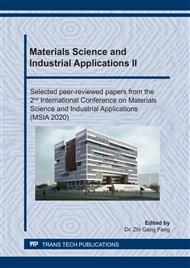p.1
p.16
p.22
p.28
p.35
p.41
p.47
p.53
The Effect of Mixed Chain Extender on the Hydrogen Bonding, Thermal and Mechanical Properties of TPUs
Abstract:
Chain extender plays a significant role in enhancing the final mechanical properties of thermoplastic polyurethane (TPUs) derived from polytetra methylene etherglycol (PTMG) and 4,4-diphenylmethane diisocyanate (MDI). In this research we focused on the effect that mixed chain extender of ethylene glycol (EG) and 1,4-butanediol (BDO) used has on the phase behavior and morphology of high hard block content TPUs. DSC, FTIR, and mechanical testing were mainly used to characterize the morphology and properties of the TPUs materials. Through this work we were able to show that mixed ratio of different chain extenders had dramatic effects on the properties of the TPUs. After mixing EG and BDO, the degree of hydrogen bonding, melting temperature, tensile strength, tear strength, and hardness of TPUs are all reduced, the glass transition temperature is increased. when the mixing ratio is 1: 1 , the elongation at break is increased to 672% . However, when the mixing ratio is n (EG): n (BDO) = 1: 2, the tensile strength is increased to 29.2 MPa, and the elongation at break is reduced to 353%.
Info:
Periodical:
Pages:
16-21
Citation:
Online since:
July 2020
Authors:
Price:
Сopyright:
© 2020 Trans Tech Publications Ltd. All Rights Reserved
Share:
Citation:


